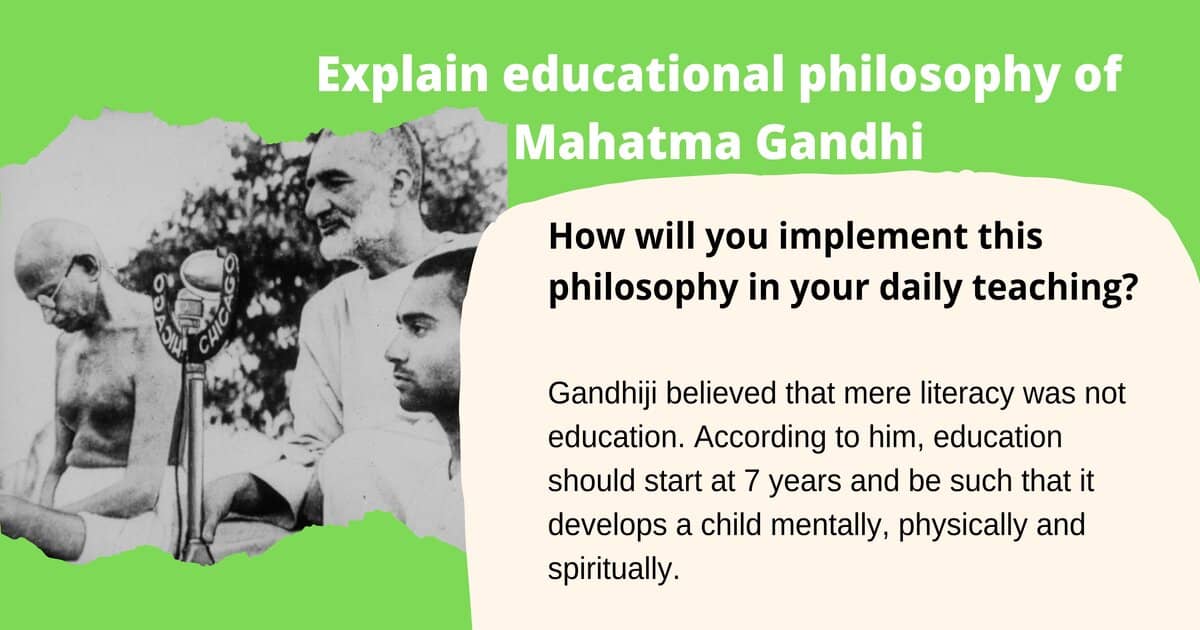Explain educational philosophy of Mahatma Gandhi and how will you implement this philosophy in your daily teaching?
by Yuvi - January 16, 2021
Educational philosophy of Mahatma Gandhi
How will you implement this philosophy in your daily teaching? Write with examples.
Introduction
Mahatma Gandhi was born on 2nd October 1969 and was more famous in the political field but he was also known for his educational philosophy His principles of Ahimsa and Truth are still inculcated among the youth.
Meaning of education
Gandhiji believed that mere literacy was not education. According to him, education should start at 7 years and be such that it develops a child mentally, physically and spiritually.
Definition
“By education I mean an all-round drawing out of the best in child and man – body, mind, spirit.”
Philosophy/Goals/Aims Of Education
Gandhiji had 2 major aims of education –
- Immediate aim – wherein
- Vocational aim – Learning of a productive craft for self-reliance and earning one’s livelihood.
- Cultural aim – All types of human activities should bare the imprint of culture and refinement and considered it as the main foundation more important than academic aspect.
- Perfect development aim – Education to develop body, mind and soul of a child in perfect harmony.
- Moral development – He gave top position to culture of heart and character development.
- Liberation – from economic, social, political and mental slavery and from worldly pursuits.
- Sociological aim – i.e. citizenship training.
Ultimate aim – Realize God through self-realization and develop virtues of truth and ahimsa.
Principles
- Medium of instruction should be mother tongue.
- Education of each child from 7 to 14 years should be free, compulsory and universal.
- Mere literacy cannot be equated with education
- Education should develop all powers of the child according to the community that he is an integral part of.
- Education should achieve harmonious development of mind, body and soul.
- Education should develop human values in the child.
- Education of all subjects should be imparted through some local craft or productive work.
- Education should create useful, responsible and dynamic citizens.
Curriculum
- The curriculum should be activity-centered.
- The medium of teaching should be the mother-tongue.
- Some craft or vocational training should be there.
- He encouraged subjects like sociology, medicine, Hindi, He also promoted physical activities.
- The curriculum for std’s. 1 to 5 for both boys and girls was to be the same and after that, boys were encouraged to take up some craft or vocation and girls were taught home-science.
Gandhiji’s scheme of education was mainly for the junior stages and was thus also called “Basic Education”.
Teaching Methodology
- He believed in a pragmatic approach where children should learn by doing.
- Reading should precede writing, and they should draw before learning alphabets.
- Craft learning should be included along with training of senses and parts of body.
- Teaching Methods should be activity based.
- Value education should be included.
Implementation in my daily teaching
- Initiate reading before writing activities are started.
- Use project method and excursion methods in geography to make it activity-based and interesting and develop their social skills.
- Impart value education to inculcate moral and character development.
- Personality development lectures to advocate how to be their own master and be free from any kind of slavery.











